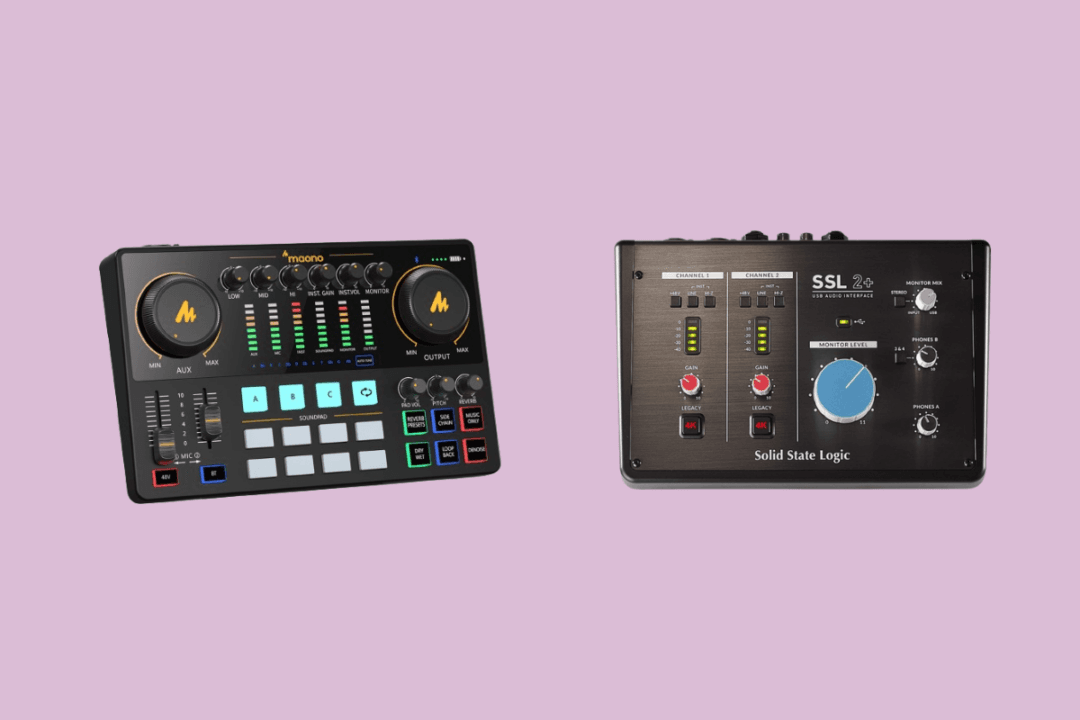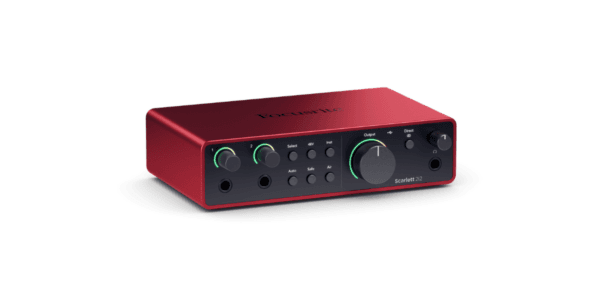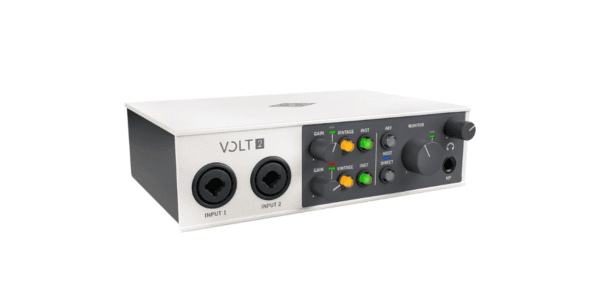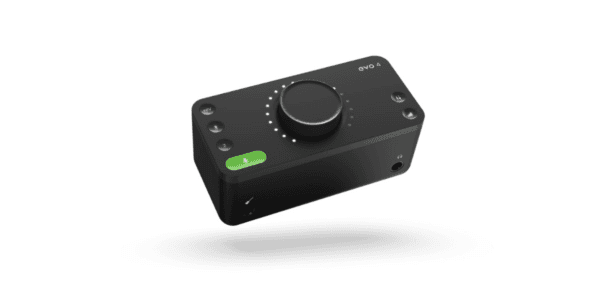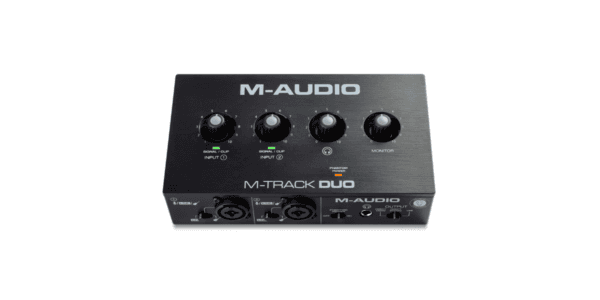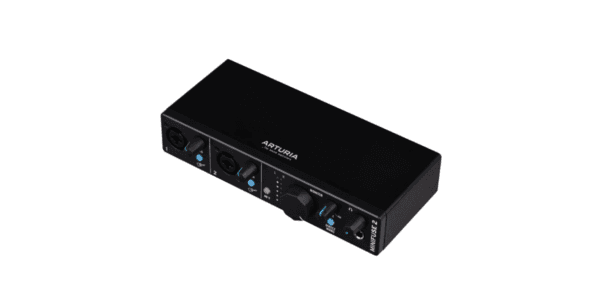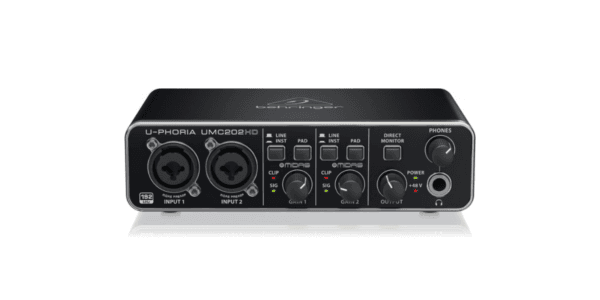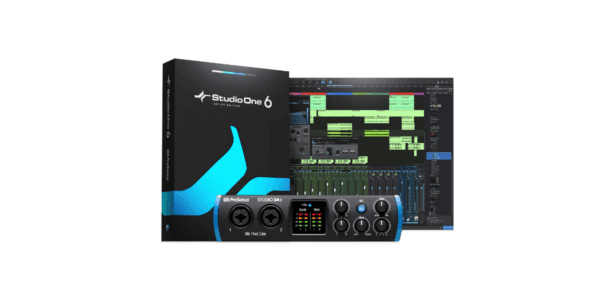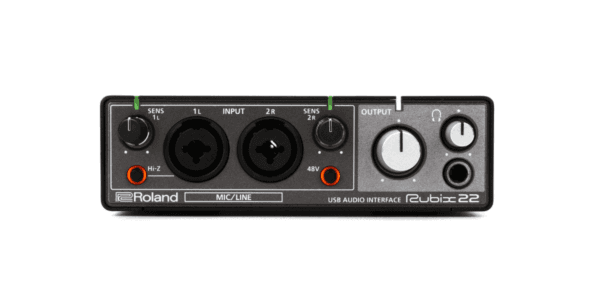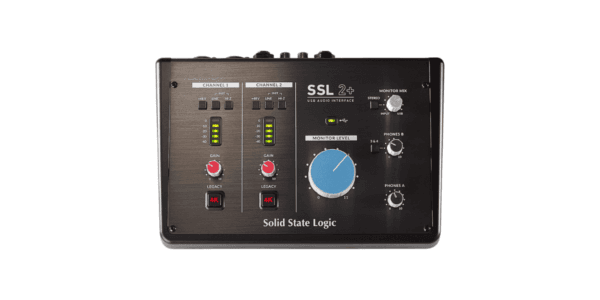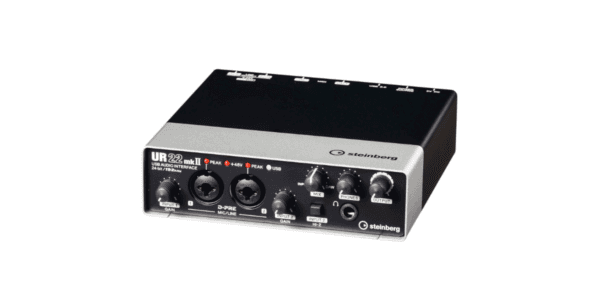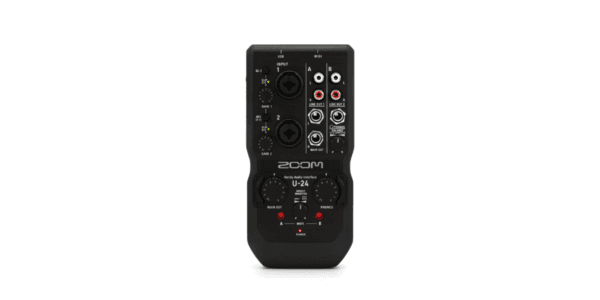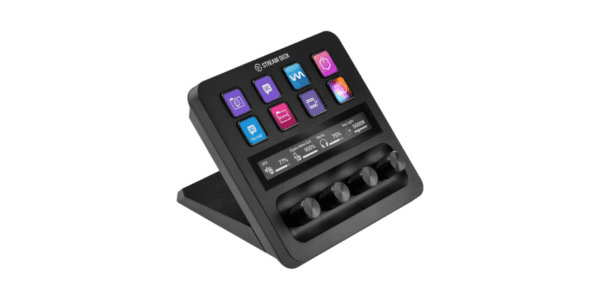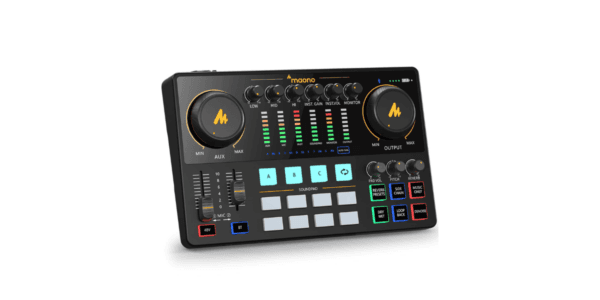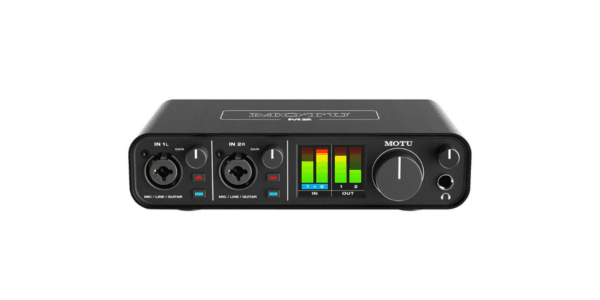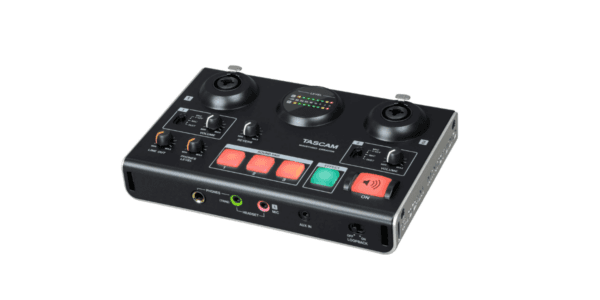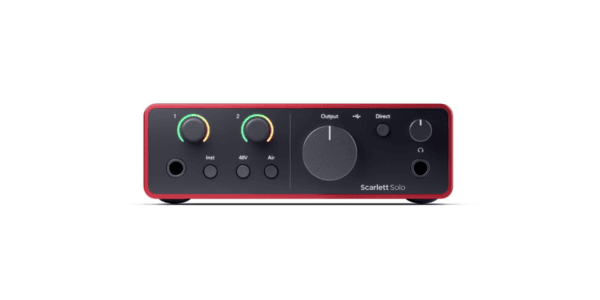The world of music production is quickly changing, where creativity has no limits, and producing state-of-the-art audio is the end goal. There’s one most overlooked hero that leads you into the ultimate auditory escapade—the best audio interface.
Whether you’re a professional who has years of experience, an aspiring artist who is looking for a consistent sound, or an audio addict who wants to capture the thrills of sound, the quest for the best audio interface is an indispensable part of your audio journey.
The Breakdown:
Focusrite Scarlett USB Audio Interface
Universal Audio USB Audio Interface
Audient EVO USB Audio Interface
M-Audio USB Audio Interface
Arturia USB Audio Interface
Behringer USB Audio Interface
PreSonus Studio USB Audio Interface
Roland Rubix USB Audio Interface
SSL USB Audio Interface
Yamaha Steinberg USB Audio Interface
Zoom USB Audio Interface
Elgato Stream Deck USB Audio Interface
Maono USB Audio Interface
Motu USB Audio Interface
Tascam Creator USB Audio Interface
Focusrite Scarlett Solo USB Audio Interface
Why Should You Get an Audio Interface?
The best audio interface is the backbone of every studio, which counts on professionalism and reliability. Once wired and connected, it will effortlessly link the tonalities and dynamics of your instruments, the rhythms of your microphones, and the endless creative features of your sound.Join us in our journey to studio-to-home sound quality and high-end connectivity via better audio user interfaces. We'll journey through the most noticeable brands to find out about their cutting-edge technologies.
This involves covering everything from the user-friendly personal interfaces designed. It varies from the portable devices beloved by mobile musicians to the imposing, serious studio hardware one can see on the desks of professional studios.
Are you a guitarist who needs to replicate a live performance in a studio? A singer looking for a perfectly clear sound? Or a producer who wants pristine mixing and mastering? In any case, this guide will be your compass for choosing the best audio interface.
The Focusrite Scarlett 2i2 4th Gen USB audio interface is a high-quality recording device designed to help you achieve better recordings with ease. As a candidate for the title of the best audio interface on the market, it features two of Focusrite’s most detailed ultra-low-noise microphone preamps.
The product offers a huge 69 dB gain range for clear and detailed sound reproduction. These mic preamps are considered to be the best ever found on a Scarlett interface.
The 2i2 also includes Hi-Z instrument and line inputs, allowing you to connect electric guitars, keyboards, synths, and groove boxes with exceptional audio quality.
The interface utilizes studio-grade converters, which are the same ones used in Focusrite’s flagship RedNet interfaces found in high-end studios worldwide. These converters deliver a huge 120 dB dynamic range, ensuring professional-grade audio conversion.
One of the standout features of the Scarlett 2i2, as a candidate for the title of the best audio interface in the market, is the Air Mode. This mode allows you to record with the character and presence of a big studio console.
It adds a high-end presence and rich harmonic drive to vocals and instruments, enhancing the overall sound quality of your recordings and turning the Focusrite Scarlett USB audio interface into a serious contender for the title of the best audio interface out there.
Pros
- Great 4th-Gen preamps: The high-quality 4th-Generation mic preamps on the device offer an impressive, wide gain range.
- Hi-Z guitar, line keys, and synth inputs: Hi-Z instrument inputs for electric guitars and line inputs for keyboards and synths.
- Superb 120 dB dynamic range audio: The interface offers sublime audio quality with a huge 120 dB dynamic range.
- No power supply: Power supply not included (requires a USB connection to a computer for power).
- Fewer inputs: There is a limited number of microphone and instrument/line inputs compared to higher-end interfaces.
- No built-in mic or headphones: There are no built-in microphones or headphones included in the bundle.
The Universal Audio Volt 2 USB audio interface is a versatile and portable device designed for musicians, songwriters, live streamers, and podcasters. It allows you to easily create music productions, live streams, and podcasts on various devices, such as Mac, PC, iPad, and iPhone.
One of the Volt 2’s standout features is its Vintage Mic Preamp mode, which delivers rich and full sound when recording vocals and instruments. This fabulous mode is based on Universal Audio’s renowned 610 tube preamp, ensuring the highest-quality audio recordings.
The Universal Audio Volt 2 USB audio interface offers high-quality audio conversion, vintage preamp emulation, versatile connectivity options, and a suite of industry-leading software.
Pros
- Versatile audio interface: It is a portable and versatile audio interface suitable for a myriad of recording applications.
- Vintage Mic Preamp: The vintage Mic Preamp mode, with the interface, provides rich and full sound quality.
- 24-bit/192 kHz audio: There is the possibility of high-quality audio conversion with 24-bit/192 kHz resolution.
- Limited to two channels: The limited number of channels may not be super ideal for larger recording setups.
- Limited compatibility: The interface’s compatibility options may be limited to specific devices and/or operating systems.
- Not enough software options: Some users may prefer access to more software options and expandability features.
The Audient EVO 4 is a Splendid USB audio interface designed for personal computers. It offers high-quality audio recording and playback capabilities with a compact and user-friendly design. The interface features two channels, making it suitable for recording stereo audio sources or individual instruments and microphones.
The product’s discrete JFET instrument input delivers unparalleled clarity and tonal characteristics for capturing the soulful melodies of guitars, basses, and other instruments.
Accompanying this remarkable feature is a multifunctional rotary control with an enchanting LED ring. This beautifully designed rotary control allows musicians to fine-tune their input levels with utmost precision.
The Audient EVO 4 USB audio interface—a contender for the title of the best audio interface—is a versatile and compact solution for recording and also playback on personal computers. With its high-quality converters, JFET instrument input, and intuitive controls, EVO 4 offers professional-grade audio performance that meets the needs of every musician out there.
Pros
- Discrete JFET input: The availability of Discrete JFET instrument input for high-quality instrument recording is a big plus.
- DSP mixer: DSP-based “low latency” software mixer with a flexible routing matrix for efficient audio processing.
- Clean EVO mic preamps: The interface includes EVO Mic Preamps for clean and transparent microphone amplification.
- No digital expansion options: There are no digital expansion options (ADAT) for additional I/O connectivity.
- Single/dual headphone output: The headphone output is limited to one or two channels, which may not be ideal for multi-artist monitoring setups.
- USB Type A: The USB Type A connector may not be compatible with all computer models, requiring an adapter or cable.
The M-Audio M-Track Duo—another candidate for the title of the best audio interface—is a compact and portable USB audio interface designed for recording, streaming, and podcasting. It provides a deliciously high-quality audio resolution of 48 kHz, ensuring pristine recordings every time.
This versatile interface features two combo XLR/Line/Instrument inputs with phantom power, letting you easily connect microphones, guitars, keyboards, and other sound sources.
The M-Track Duo weighs only around 12.7 ounces, being quite a compact device of 4.34 x 7.5 x 2.13 inches. It is a beautiful gadget that has B08Q1V77NR as ASIN.
The M-track Duo has been advertised as a feeler for the gold champion’s belt among the best audio interfaces. It is suitable for those looking for portable and user-friendly solutions to their recording, streaming, and podcasting requirements.
Saving you precious space with its nice design, this superior studio monitor contains many more flexible inputs, mighty preamps that preserve the audio quality, and a bundle of included software.
Pros
- Portable and compact design: This audio interface is ideal for on-the-go recording, streaming, and podcasting.
- Versatile connectivity: It offers versatile connectivity with two combo XLR/Line/Instrument inputs, accommodating various sound sources.
- Crystal Preamps: These preamps ensure optimal sound quality from all types of microphones, including condenser mics.
- Limited features: Some users may prefer additional features or controls found in higher-end audio interfaces.
- Limited accessories: The interface May require additional accessories and/or cables depending on specific recording needs.
The Arturia MiniFuse 2 is a compact USB audio and MIDI interface designed for recording, production, podcasting, and guitar applications.
It comes with creative software that enhances your recording experience tremendously! This outstanding product is backed by a 5-year warranty, which reflects its durable construction and rigorous testing process. With the MiniFuse 2, you can create music anytime and anywhere, thanks to its plug-and-play functionality that allows for quick and easy setup.
This product is beginner-friendly and comes with bundled software to help you get started wherever you may be. It provides super-easy tutorials, exclusive ready-made song projects, and a selection of creative software.
This bundle includes software that helps you create music. The first program is Ableton Live Lite, which helps you generate creative ideas for songs.
The second program is Analog Lab Intro, which offers more than 500 high-quality synth sounds. The third program is Arturia FX, which provides vintage mixing effects. The fourth program is NI GUITAR RIG 6 LE, which helps you create guitar tracks.
The fifth program is Auto-Tune Unlimited, which assists you with vocal melodies. Finally, the Splice Creator Plan gives you access to perfect samples and loops.
The widely acclaimed Arturia MiniFuse 2 is one of the best audio interfaces on the market. It is a feature-rich USB audio and MIDI interface that renders impeccable sound, offers versatile connection options, and includes creative software in the bundle.
It is designed to be durable and comes with a 5-year warranty for added peace of mind on the part of the users. Be it a musician, a podcaster, or a content creator, MiniFuse packs all the necessary features to be your perfect music companion. It can literally brighten your sound and make you heard across the world.
Pros
- Compact design: Compact and portable design, allows you to record and produce music anywhere with the utmost ease.
- High-quality audio specs: Ensuring sharp, crystal-clear sound quality for guitars, vocals, and other instruments of choice.
- Versatile connectivity options: Including combo XLR inputs, TRS inputs, balanced line outputs, headphone outputs, and MIDI connection.
- A limited number of channels (2): Which may, in some cases, be insufficient for super-complex recording setups
- USB Type C connector: May not be compatible with all devices, requiring the hassle of having to use adapters or additional cables
- OS dependability: The product’s performance may indeed be subject to the capabilities of the user’s operating system (Windows) and computer hardware
The Behringer U-Phoria UMC202HD is one superior USB audio interface designed for recording and producing music joyfully! This greatly useful product is manufactured by Behringer, a well-established brand in the audio equipment industry.
This splendid interface offers the musicians two channels, allowing them to connect and record from two different sources simultaneously.
With its handy USB connectivity, the U-Phoria UMC202HD easily connects to your computer. It is compatible with popular recording software, such as Avid Pro Tools, Ableton Live, and Steinberg Cubase.
This flexibility allows you to use your preferred software for recording, editing, and mixing any audio project whatsoever.
The U-Phoria UMC202HD offers a phantom power output for those who may opt to use a condenser microphone. These microphones need additional power to run on. Actually, phantom power makes it possible to work with the maximum set of microphones.
This explains why U-Phoria UMC202HD is ideal for instrumental and vocal performance in the studio due to the way it captures these instruments in high resolution and extreme detail.
As a candidate for the title of the best audio interface out there, U-Phoria UMC202HD provides users with reliability and high functionality at a low cost. It is meant for musicians, producers, and audiophiles of all levels. In particular, its compatibility with popular recording software, phantom power internal feature, as well as powerful headphone output. Plus, the durable design makes it a preferred option among those looking for top-notch audio recordings.
Pros
- Phantom power support: The availability of phantom power support for condenser microphones is a big plus.
- Highly compatible: Compatible with popular recording software such as Pro Tools, Ableton Live, and Cubase.
- Not the best option for Pros Some users may prefer a different brand or higher-end model for professional use.
- Too light: The item weight is relatively light, which may affect stability on a desktop or studio setup.
The PreSonus Studio 24c is yet another contender for the title of best audio interface. It is designed to enhance your overall recording experience in any project of your choice.
It is compatible with personal computers and offers a marvelous range of features to capture high-quality audio. The interface is powered through a USB connection. This takes away the annoying need for an external power supply. On top of that, it comes with USB-C to C and USB-C to A cables for easy connectivity.
One of Studio 24c’s notable aspects is that it has two XMAX-L Class-A Mic preamps. These onboard preamps provide an extra level of detail so that every minute detail of your sound can be captured with unsurpassed clarity.
The interface also offers studio-grade converters, which can be used for recording or playing back music files of up to 24 bits or 96 kHz.
Monitoring your recording level has also become easier with ladder-style LED metering, which guides you accordingly in your audio leveling. In addition, the interface gives you virtually no-latency direct monitoring, guaranteeing that you can check your audio and mix it in real time without any hint of a delay.
The Studio 24c is small and light and can fit comfortably in a hand pocket or small bag. It weighs in at only 1 pound (453 grams) and measures 7.09 x 6.3 x 1.77 inches. It is built in the United States and has received positive feedback on its performance and quality, making it worthy of the title of the best audio interface out there.
Pros
- Quality mic preamps: It includes two high-quality XMAX-L solid-state mic preamps for capturing detailed audio.
- Low-latency direct monitoring: Features ladder-style LED monitoring and low-latency direct monitoring for easy level control.
- High-headroom instrument/line inputs: Offers two high-headroom instrument/line inputs for recording guitars, bass, and other line-level devices.
- Limited channels: Limited to just 2 input and 2 output channels, which may not be sufficient for larger recording setups.
- May require adapters: The USB-C connectivity may require adapters or additional cables for compatibility with older devices.
- Set DAW software: Some users may prefer a different DAW software than the included Studio One Artist and Ableton Live Lite.
The Roland Rubix 22—believed by many to be the best audio interface on the market—is a modern USB audio interface tailored to the needs of musicians and producers.
This interface gives you a 2×2 interface, thus enabling the connection of two audio sources that can be recorded or played back simultaneously. Developed for Windows PCs, it can be connected using a USB port and does not require much configuration on the part of the user.
An essential part of the RUBIX-22 are its two low-noise Mic Preamps with XLR Combo Inputs. These preamps pick up clear audio and high-fidelity sounds, making them ideal for recording vocals and other acoustic instruments.
Besides, the Hi-Z input for guitars and other high-impedance devices lets you bring in your source materials directly for the recording through the mixer.
The user interface involves MIDI In/Out ports as well, which allows you to connect MIDI devices like keyboards, synthesizers, and drum machines. This means the world to musicians, as they can do lots of additional things and collaborate with MIDI-controlled hardware and software in the process.
The Rubih 22, as a candidate for the title of the best audio interface, is surrounded by robust protection and a low-noise design. It simply means that interference and noise contamination is reduced to a minimum. This particular aspect allows the listener to enjoy music in the same format as the artist created it, which makes it quite significant.
Pros
- Cost-effective: The interface provides a balance between features and cost, offering a cost-effective solution for recording and production needs.
- Low noise: The Rubix22 is engineered to have extremely low noise from input to output, resulting in a clean and clear audio signal.
- Compatible with Mac and PC: The Rubix22 is compatible with both Mac and PC computers, offering seamless integration with different operating systems.
- 2 channels only: The Rubix22 has 2 channels, which may not be sufficient for complex recording setups requiring multiple inputs and outputs.
The SSL SSL-2 Desktop USB Type-C audio interface bundle is arguably the best audio interface provided by Solid State Logic. This is a product specially created for delivering premium sound, durable construction, and flexible connectivity to musicians, audio engineers, and multimedia production staff.
The interface has 2 external and 4 internal audio connection ports, allowing it to be used in a wide range of studio setups, including tracking and mixing.
One of the standout features of the SSL-2 is its two SSL-designed microphone preamps. These preamps offer excellent noise performance and a wide gain range, ensuring pristine audio capture. The interface also includes the Legacy 4K feature, which adds analog color enhancement to any input source. This feature is inspired by classic SSL consoles, giving your recordings a vintage touch.
The SSL-2 gives out two headphone outputs with great current flow capability which is pro-grade. The interface is also USB 2.0 compliant. This eliminates the need to use an extra power source. It works with both Mac and PC, which makes it rather an approachable tool for users with different preferences.
Certain extras, like studio monitor headphones, MIDI cable, and XLR cable, are also included in the SSL-2+ audio interface package to assist users with all of their recording requirements.
Pros
- Legacy 4K analog color enhancement: Inspired by classic SSL consoles, for adding character to your recordings
- Pro headphone outputs: The SSL audio interface offers two professional-grade headphone outputs for convenient monitoring.
- SSL production pack software: It comes with the SSL Production Pack software bundle, offering additional tools for music production.
- Limited channels: Limited to 2 input channels and 4 output channels, which may be insufficient for larger recording setups
- Set software bundle: The bundled Studio Monitor Headphone, MIDI Cable, and XLR Cable may not meet the preferences or requirements of all users.
- Not enough connectivity options: Some users may prefer more connectivity options, such as additional inputs/outputs or digital connectivity.
The Yamaha Steinberg UR22MKII is a 2-channel USB audio interface, that is made for use by musicians and producers. The unit UR22MKII has a 2 x 2 USB 2.0 capability, which allows data transfer in a very fast and dependable manner.
It offers you the largest maximum audio resolution of 24 bits/192 kHz, guaranteeing the best sound quality for recordings.
Whether you make use of commonly-used software products such as Cubase, or any other major software products out there, this interface will seamlessly integrate into them. Furthermore, it supports important MIDI functions since they enable MIDI input and output.
Connectivity-wise, the iPad holder allows the UR22MKII to work with your iPad. This means you can work on your projects and use your iPad to improve your creativity.
The interface is provided with 8 inches of depth, 9.2 inches of width, and 4 inches of height. It has a weight of around 3.4 pounds and can be transported and used on mobile productions without extra effort.
UR22MKII is compatible with Mac OS X 10.7, 10.8, 10.9, 10.10, and 10.11. As a candidate for the accolade of the best audio interface, it also supports Windows 7 SP1, 8, 8.1, and 10. It uses USB 2.0 as an interface and operates on a single lithium-ion battery.
Pros
- Highly compatible: This Yamaha audio interface is compatible with major audio editing, mastering, and music production software.
- Versatile usage: It comes with MIDI input/output and iPad connectivity for versatile usage which is a big plus.
- Compact design: The compact and portable design of Yamaha Steinberg’s USB audio interface is suitable for operation, or mobile production.
- Battery-dependent: The Yamaha Steinberg USB audio interface requires a separate lithium-ion battery for operation which can be a hassle at times.
- Limited accessories: Some of the users may require additional accessories or cables for specific connections.
The Zoom U-24 Handy audio interface is an all-in-one USB audio interface that is lightweight and also multi-purpose to facilitate recording and usage on the move. It suits personal computers and provides the options of multi-channel and stereo for high-quality audio processing.
As a candidate for the accolade of the best audio interface available in the market, U-24 extends the internal audio connection possibilities, providing two quality microphone and line inputs for different professional applications through its incredible mic preamps.
A weight of 0.63 pounds and the dimensions of 7.25 x 3.75 x 1.5 inches are the U-24’s size specifications. It is the size of a small box with portability to be used by medium-sized bands and other audio enthusiasts who only need a reliable audio interface while on the move.
The Zoom U-24 Handy audio interface is designed to produce quality and high-end sound, whether recording or performing. Good-quality preamps, a variety of connection options, and the software that comes with it make this interface ideal for music artists, podcasters, and content creators.
Pros
- Portable design: The compact and portable design makes it suitable for on-the-go recording and performances.
- Highly compatible: Zoom USB audio interface is conveniently compatible with PC and Mac operating systems.
- Limited inputs: Limited to two XLR/TRS combo inputs, which may be insufficient for larger recording setups.
- Battery-dependent: The interface requires 2 AA batteries or an optional AC adapter for power, which may be inconvenient for some users.
The Elgato USB-C Stream Deck + is designed to stream in a simple and fun way. As a contender for the title of the best audio interface, it is an essential product for every creative streamer, gamer, and content creator.
It is an all-in-one device. This intuitive remote control comes with LCD keys, touch strips, and dials that give the user the right feel and have different uses.
Whether it is an audio mixer or studio controller that you need for sound creation, or a production console for live sound mixing or recording, Stream Deck + can be designed according to your wishes.
The other notable aspect of Stream Deck + is its ability to perform multiple tasks. Besides that, the device is able to switch between different forms of interface configuration, which are used for various kinds of applications.
Stream Deck, supported by the fervent developers’ community, gains enormous potential by using various plugins to extend its capabilities. The list of popular plugins includes Elgato Wave Link for controlling audio mix, Camera Hub for camera streaming, Control Center, and more. There are also different popular plugins such as OBS, Twitch, YouTube, Twitter, Discord, Spotify, Philips Hue, and many more.
Pros
- Intuitive user experience: Tactile control with LCD keys, touch strips, and dials, providing a hands-on and intuitive user experience.
- Customizable functionality: Fully customizable functionality allows for various applications such as audio mixing, studio control, and production console.
- Smart profile features: Multi-action and smart profile features enable the execution of multiple commands simultaneously or sequentially, enhancing workflow efficiency.
- Dependent on corded electric power source: Requires a corded electric power source, limiting portability and flexibility in placement.
- Limited compatibility: Limited compatibility to Windows 10 (64-bit) or newer and macOS 10.15 or newer, potentially excluding older systems.
- Limited connectivity options: Restricted connectivity options to USB-A and USB-C, which may not be compatible with all devices.
Maono Caster AME2 lets you control the volume of the audio pads. You can upload your favorite audio to the Digital Audio Workstation controller, which is then played back during your podcast recording session via your smartphone, PC, microphone, or Bluetooth device.
Also, as a serious contender for the title of the best audio interface out there, AME2 is suited for tasks connected with recording musical instruments, like guitar and bass. It comes with a jack of 6.35mm for linking these pieces of equipment.
AME2 features different connectivity options. You can use the USB-C connector to connect your laptop or tablet, the output ports of the Live-Output1/2 for podcasting and streaming on a smartphone, and a studio monitor of the Monitor SPK for sound output.
With an AUX-IN, the computer can connect to accompany audio input from a smartphone or other devices. MIC1/2 can also be used to connect with an XLR condenser/dynamic mic of your favorite type, while the INST is meant to pair with a guitar, bass, or any other instrument of your choice.
Pros
- Enhanced podcast atmosphere: 10-channel mixer with adjustable volume and loop recording for enhanced podcast atmosphere.
- 6.35mm jack: Suitable for recording guitar, bass, and other instruments with a 6.35mm jack, which is ideal.
- Plug-and-play experience: You can experience crystal-clear audio recording, sleek design, and wide device compatibility with this interface.
- Limited accessories: The purchased bundle Includes an audio interface, cables, and a manual. Additional accessories may be required.
- Learning curve: Some users may need time to learn all the features and controls, as they might be super user-friendly.
One of the standout features of the Motu M2 is its use of ESSSabre32 Ultra DAC technology, which brings about high-quality analog sound reproduction. This feature is mainly prevalent in audio interfaces that come with an expensive price tag, while Motu M2 is quite reasonably priced. This brings down the cost factor for those aiming at top-quality audio.
Moreover, Motu M2 offers high-quality preamp circuits that ensure quality performance. Zero internal noise inherent in the mic inputs at -129 dBu recording levels allows for clean and noise-eliminated recording.
The ESS converters are also the driving power of the headphone output that can compensate for integrated headphone amplifiers which cost a lot more on their own.
The M2 is believed by some users to be one of the best audio interfaces on the market. Considering its price, the M2 is a product designed for musicians, producers, and sound lovers who are seeking low-latency monitoring while recording from live inputs.
The MOTU interface is equipped with proprietary drivers that ensure a minimal 2.5 ms latency. Thus, it is suitable for real-time monitoring and processing in general.
Pros
- Ultra-clean preamp circuits: Features ultra-clean preamp circuits with a measured -129 dBu EIN on the mic inputs, ensuring noise-free recordings.
- Expertly engineered USB drivers: Provides best-in-class speed for monitoring live inputs with low latency, thanks to expertly engineered USB drivers.
- Precise control: The full-color LCD display with detailed level meters for all inputs and outputs enables precise control over audio levels.
- Limited Software: Supported software limited to Ableton Live Lite and MOTU Performer Lite, potentially requiring additional software for specific needs
- Heavy: A relatively heavy weight of 3.21 pounds may not be as portable as some other audio interfaces
The Tascam MiNiSTUDIO Creator USB audio interface is a candidate for the title of the best audio interface in the market. It uses the latest technology, such as high-speed USB and 96kHz/24-bit AD/DA converters, to deliver high-quality audio feeds to both computer recording software and traditional audio gear.
The US-42B MiniSTUDIO is mainly used for podcasting and streaming. It’s not only a final product facility but also a production studio with professional-grade effects and real-time filtration, making it a perfect tool for upcoming net influencers.
This device represents a USB 2.0 computer line with the option to connect it to personal computers that are in compliance with USB Audio 2.0 standards. It consists of two HDDA (HD DDA) mic preamps, which offer cutting-edge sound like what you get in a studio.
Tascam MiNiSTUDIO Creator can work with Audacity, Cubase, Garageband, Live, Pro Tools, SONAR, and Studio One, which gives you a choice of programs for recording and editing.
Pros
- Balanced inputs and phantom power support: Two HDDA mic preamps with XLR/TRS input jacks provide balanced inputs and +48V phantom power.
- Enhanced audio control: Dual 4-band parametric EQ and adjustable onboard compression for enhanced audio control.
- Electric or bass guitar connectivity: Features two Hi-Z 1/4” inputs for connecting electric or bass guitars.
- Learning curve: The software may have a learning curve for users unfamiliar with audio production.
The Scarlett 4th Gen USB audio interface is truly a powerful audio interface that is mainly used for recording music. As a contender for the accolade of the best audio interface, it comes bundled with the Waves Musicians 2 software package, which includes six essential audio plugins.
The Scarlett Solo exhibits studio-quality conversion technology with an astonishing 120 dB dynamic range. It produces a purely professional sound quality you would experience in a professional recording studio.
It features a super-quiet mic preamp, which humanizes your recordings. With any microphone available on the market, you can achieve great sound quality.
The hi-Z instrument input is designed for guitar connection straight away, giving the channel the proper realism needed to satisfy guitarists’ need for authenticity. Scarlett Solo is portable and meticulously designed. Its lightweight construction makes this instrument the tool that will allow you to make music wherever you are.
Pros
- Waves Musicians 2 software: Includes Waves Musicians 2 software bundle with 6 indispensable audio plugins.
- 120dB dynamic range: It offers a huge 120dB dynamic range comparable to professional studio interfaces.
- Limited inputs and outputs: Limited number of inputs and outputs compared to higher-end audio interfaces.
- Learning curve: The bundled software may require an additional learning curve for users who are not familiar with it.
Audio Interface Reviews
Here, you can explore a curated selection of audio interface reviews, helping you choose the perfect audio interface for your needs. Let’s dive in and discover the best options!Focusrite Scarlett USB Audio Interface
Many customers appreciate the overall performance and value provided by the Focusrite Scarlett USB audio interface. Its sensational ease of use stands out as a major plus, with most finding it very user-friendly. According to reviews, the advertised features seem to work reliably. Also, for the price asked, many feel it is a good value and works well enough for basic recording purposes.However, the audio interface reviews are somewhat mixed when it comes to other areas. Sound quality receives a varied response; while acceptable for many basic needs, some mention it is not on par with the best of the best. The bundled software also generates some disagreement. Latency seems to be another divisive issue.
Universal Audio USB Audio Interface
The Universal Audio USB audio interface, as a candidate for the title of the best audio interface on the market, is a popular choice among hobbyists and professionals alike due to its excellent build quality and feature set.Perhaps most impressive about this particular interface is what you get for the money. At its affordable price point, this audio interface punches well above its weight class. It also comes with a sleek and durable design that looks professional in any studio setup.
Audient EVO USB Audio Interface
The Audient EVO USB, which has been considered an intense competitor for the title of the best audio interface, has been given both bad and good remarks by the customers!It can be noted that, on the one hand, numerous people are in a praising mood for the fact that it has much that is easy to use and provides exceptional sound quality. Nevertheless, some customers reported the presence of noise. It has come to their attention that the headset sound is not 100% silent and can pick up interference or ambient noise in some circumstances.
M Audio USB Audio Interface
The M Audio USB audio interface seeks to provide users with a simple and cost-effective alternative. End-user reviews have pointed out that the ease of its setup and compact size are the main reasons behind its success. Additionally, the product pricing seems to be quite attractive.However, the software accompanying the interface has been a source of frustration for some reviewers. The user experience when operating the provided applications leaves room for improvement. Seemingly, a more polished software suite could enhance the overall product.
Arturia USB Audio Interface
The testimonials about the Arturia USB Audio Interface for the title of the best audio interface show that people have a lot of respect for this model due to its high-quality audio and its ability to work properly under different conditions.Customers praise the sound quality, observing that it delivers a nice, clear, and natural sound for audio production and recording purposes. In addition, the solid build quality is a notable attribute.
Behringer USB Audio Interface
The majority of the audio interface reviews on the market give Behringer USB credit for its excellent process supervision, outstanding value, and ease of use it offers. Customers emphasize that the interface is very easy to navigate and set up.It is visually appealing and customizable to match the user’s needs. Moreover, they talk about the very good overall quality of the product, including the output, which is free from any lags and buzzes during audio and MIDI processing.
PreSonus Studio USB Audio Interface
Most reviews emphasize how PreSonus Studio USB audio interface excels as the user-friendly core of any studio setup. Its wide compatibility, stable hardware, and customizable controls continue to make it a beloved choice. While software quirks exist, few interfaces at this value point provide such an effortless sonic experience.Generally, users are content with the PreSonus Studio as one of the most essential elements of any studio. With widely suitable hardware that is customizable, it is one of the most desired options available.
Roland Rubix USB Audio Interface
The Roland Rubix USB audio interface is well-known for its dependable engineering and intuitive design. Many audio interface reviews appreciate the build quality and efficient setting process.While it is acknowledged that the interface is outstanding for the highest studio quality use, there are concerns with sound purity and functional response over different applications.
SSL USB Audio Interface
The SSL USB Audio Interface, for the accolade of the best audio interface, has received positive reviews from satisfied customers. Many mention that this device delivers the expected value for what they paid for, as it enhances the audio output of the microphone just right. Due to its compact and space-saving design, the interface is a solution for either studio or outdoor recording.Customers also mentioned that the setup is easy and the software is simple to use. You do not have to go through pages and pages of technical manuals, as the user guide makes it easy to start the audio interface right away.
Yamaha Steinberg USB Audio Interface
There are good and bad reviews about the USB interface from Yahama Steinberg. They appreciate the solidly built construction and the good value for money. However, their views on its performance differ.The audio interface reviews in favor of this product note that its sturdy chassis feels like it can withstand rigorous studio use. At its affordable price point, fans say it delivers recordings on par with costlier competitors. The complaints center around inconsistent audio quality, latency problems, and intermittent crashes reported by some.
Zoom USB Audio Interface
The Zoom USB audio interface, as a candidate for the title of the best audio interface, is generally well-received by customers for its performance, usability, and solid construction.However, some criticisms have been voiced regarding its audio playback and microphone input quality. Certain microphones appear to have weak signal levels when connected to the interface. Additionally, some users report that audio played back through the interface can sound muffled or lack clarity at times.
Elgato USB-C Stream Deck USB Audio Interface
The audio interface reviews for the Elgato USB-C Stream Deck praise the fact that its integrated controls allow seamless management of levels, effects, parameters, and more—sometimes all at once. For many users, this one-stop operation streamlines complex sessions into smooth workflows.However, button responsiveness and certain digital aspects still have room for improvement, according to some. Regardless, the all-in-one nature of this audio interface can more than handle a diversity of audio applications.
Maono USB Audio Interface
The Maono USB audio interface, as a candidate for the title of the best audio interface, has drawn mixed opinions from customers. While the core functionality of interfacing with audio equipment and controlling parameters is appreciated, there are also issues that cause disappointment.Customers note frustrations with certain design flaws. The single XLR mic input is seen as too limited for their needs. Additionally, the interface’s microphone appears to be overly sensitive and outputs at an extremely low level, meaning it may not pick up sounds as desired. Battery life is another pain point, according to some reviews.
Motu USB Audio Interface
Audio interface reviews of Motu USB were mixed. Many praised its performance, build quality, and ease of use. Users found the device worked remarkably well for its purpose. Both the physical knobs and digital controls felt sturdy and responsive, according to most testimonials.However, sound quality seemed to divide opinions more than other elements. Some high-end audiophiles criticized it for not rivaling true professional-quality sound. A few experiments also hinted that it struggled more than pricier options in noisy electromagnetic environments.
Tascam MiNiSTUDIO Creator USB Audio Interface
As another contender for the position of the best audio interface, Tascam MiNiSTUDIO Creator is very easy to use. It is suitable for basic uses such as two-person podcasts in a single room. Right out of the box, everything just works seamlessly.At its affordable price point, it’s difficult to find better value. Navigation and control are intuitive. The sound quality, convenience of controls, and outstanding price make this a decent hobby and a good choice for amateur podcasters.
Focusrite Scarlett Solo USB Audio Interface
The audio interface reviews on Focusrite Scarlett Solo indicate that it is extremely compact yet provides excellent audio quality for its size. The sound is well-balanced overall, with clear highs, mids, and bass.While this speaker’s audio performance is quite impressive, one issue the reviewers have experienced is frequent disconnects when paired via Bluetooth. The connection will drop unexpectedly every few minutes, requiring the user to manually re-pair the devices.
Facts about industry
The audio interface industry is experiencing a surge in growth at this juncture. This is mainly due to the rising demand for high-quality sound output from sound recording and production equipment.
The business offers a range of audio interface types to cater to the needs of musicians, podcasters, streamers, and audio specialists. These include beginning to professional-grade gadgets.
Uninterruptedly developing technology has been the essential factor responsible for the evolution of the manufacturing sector. The development of advanced digital signal processing, connections, and software integration has created higher quality, less laggy, and more flexible workflow situations for users.
This has given professionals and amateur enthusiasts in audio the opportunity to have the same high-quality results as the ones that experts and recording professionals get.
How do I Choose the Best Audio Interface?
The main parameters that determine which audio interface you should select for your particular niche have to be carefully examined. To begin with, prepare the list of components that you need.Consider the number of input and output ports that you’ll need, as well as the types of connections available, including USB, Thunderbolt, and other options.
As you go shopping for the best audio interface, you may also be looking for features like MIDI support and phantom power (for condenser mics) or digital I/O (inputs and outputs).
Furthermore, it is vital to check the sample rate and bit depth of the audio interface as well. A higher sampling rate (e.g., 44.1 kHz, 48 kHz, 96 kHz) and a larger bit depth (16-bit, 24-bit) will be apt to get better sound quality, but they will also need more processing power.
If your workflow needs prime, real-time interaction, such as for live performance or sound recording, then you should investigate the latency specifications of the interface you are considering.
Do All Audio Interfaces Sound the Same?
As far as audio interfaces are concerned, they typically offer a variety of distinct features and performances, but their goal generally remains the same. They aim to provide a realistic and honest audio output.It’s important to know that the quality of an audio interface can vary depending on the specific model. Some audio interfaces have better circuitry and digital-to-analog converters (DACs), which can produce a more detailed and rich sound compared to budget models.
What is more, microphone preamps would also play a role with the sound quality enabled, high-grade interfaces, usually providing clear and transparent amplification. Consequently, although audio interfaces may have a common aim, their sound quality could vary considerably, depending on what components and design options have been selected by different manufacturers.
How Do I Know If My Audio Interface Is Good?
When evaluating the best audio interface, there are several key factors to consider to ensure you get a high-quality device that meets your needs:Delay - Find an interface with a low delay. This feature, more than many other features, is essential for real-time monitoring and performance analysis. Go for a latency under 10 ms at least.
Preamp quality - The preamps must be noise-free and capable of providing clean amplification for your sound sources, such as microphones and instruments. Top-market preamps that offer more detail and nuance in the music will lead the way.
Conversion Quality - Make sure that the analog-to-digital and digital-to-analog converters offer a high bit depth to procure clear and fine audio quality.
Build Quality - Go for an interface with heavy-duty, strong construction, able to handle studio or live performance conditions continuously.
Analyzing these technical conditions lets you pick the best audio interface that meets your particular recording and production needs.
Can I Use 2 Audio Interfaces at the Same Time?
The answer is that it is definitely possible to use two audio interfaces simultaneously. Many modern laptops have the processing capability and memory capacity to handle different sound cards without problems.This is true, but nonetheless, you should always make sure that your software and drivers are compatible and properly set up to allow you to use multiple audio interfaces.
Sometimes, DAWs (digital audio workstations) and multimedia applications have an integrated interface that can be useful for controlling audio signals from different media.
This feature is especially helpful in cases where you want to combine multiple tracks or use them as backups, possibly during live music performances or when setting up complex routing scenarios.
Do I Need Speakers for My Audio Interface?
An audio interface converts analog-to-digital signals and vice versa. Nevertheless, some models considered to be candidates for the best audio interface have a speaker installed, but the speaker is not usually available at the interface part of most audio interfaces.It will, then, be necessary for you to link external speakers or headphones to the interface for sound to be heard. It means you can check on the audio signals and make any changes or recordings as needed. Without having external speakers or headphones, you couldn’t hear the audio that was being processed by the audio interface.
How Many Audio Interfaces Do I Need?
To put it simply, the required quantity of audio interfaces can be determined by your individual production process and requirements. One well-engineered interface, instead of multiple cheap ones, may well become an element of a home studio or recording ensemble’s audio setup. On the other hand, you may have been working with only one source and need to record multiple audio sources, such as vocals, guitars, and keyboards, at once. In this case, it might become too hard to manage, and you may even need two or more audio interfaces.
The audio interface’s number of inputs and outputs, in addition to the type of connections it offers (USB, Thunderbolt, etc.), also defines the minimum/maximum interfaces needed for your dedicated setup and specific needs.
Does an Audio Interface Affect Sound Quality?
The best audio interface plays a very meaningful role in overall audio system sound performance. The intrinsic elements of the interface features, which involve the analog-to-digital converter, the preamps, and the clocking circuits, are crucial to getting the most out of the audio quality. They determine the clarity, dynamic range, and noise floor of the recorded or played back audio.The use of high-end machines with premium components achieves a better-sounding audio interface. It usually results in a transparent and detailed sound compared to a lower-end model.
Moreover, the interface type (like USB, Thunderbolt, and FireWire) along with computer quality (e.g., processing power and multicore capabilities) are also factors that play a role in the capacity of the interface’s performance and the audio quality.
Can I Mix Without an Audio Interface?
While using your computer’s sound card as your mixing tool is technically possible, it is, however, not advisable. In truth, onboard audio interfaces are rarely fine-tuned for audio production and normally have higher latency, less accurate sounds, as well as low input/output choices.On the contrary, it can make it difficult to achieve the desired high-quality level in mixing and mastering. To achieve the highest possible sound quality and comfort, we strongly suggest using the best audio interface completely devoted to professional sound production.
These interfaces are designed with superior A/D and D/A conversion along with lower latency. It makes them quite flexible for juggling creativity in music-forming and sound-engineering ecosystems.
How Much Should I Spend on an Audio Interface?
The amount of money you allocate to an audio interface highly depends on the criteria you’re considering, such as your budget, the features you need, and the quality you want.You may not want to buy the most expensive or best audio interface, but you also do not want to go for one with only average sound quality. In this case, the cheapest one you can buy that is still worth it will cost you around £100.
However, suppose you have a larger budget and the need for more than just basic features such as dual inputs/outputs, higher sampling rates, and professional conversion. In this case, expect to pay anywhere from $200 to $500 or even more. Fundamentally, the type of audio interface fit for you will largely depend on your plans and reasons for setup creation.
Is It Safe to Unplug the Audio Interface?
Normally, pulling an audio interface from your PC or power source is safe. However, to lower the chances of data loss and electrical problems, one should make sure to adhere to the set procedures for securing the devices.Next, it is advised to close all programs or applications that are currently in use before disconnecting the audio interface from the device’s USB port. It guarantees that data will not be corrupted or lost due to the processes of writing and memory management.
Also, confirm that there is no audio involved in the process and that the interface is either actively recording or playing the media. Removing the plug abruptly can create undesirable sound artifacts or even device failures. Being cautious about the steps mentioned above can guarantee the best and safest unplugging experience for your audio device.
Do Audio Interfaces Reduce CPU Usage?
Indeed, audio interface software tends to use many CPU units when processing low latency in real-time or when distributing FX channels. Nevertheless, the interfaces that come with integrated Digital Signal Processing (DSP) can execute certain tasks from the list of CPU-intensive operations. And this reduces the overall amount of CPU usage.The DSP processors in the best audio interface are responsible for functions like A-D conversion, sample rate conversion, effects processing, and other signal-processing tasks. This frees up the host computer’s CPU to focus on others. It is also of great help in cases where the system has a limited CPU or the audio applications have to run together.
How Loud Should My Audio Interface Be?
When the sound level is set at an optimal level, the volume of the audio interface should be similar to the volume of different signal sources. Well, it’s all about your taste and the sound tolerance of your external speakers or headphones.It is always advised that the sound or audio level should not be so loud that one fails to hear the smallest detail of the audio or the distorted sounds. The best volume level is different for each particular piece of equipment, the type of sound, and even your personal tastes.
A good starting tip is establishing the volume at which you can listen to all nuances of the audio without any strain causing clipping or distortion to the audio.
Conclusion
The importance of having a high-quality audio interface cannot be overstated in the world of music production. Regardless of your level of experience, investing in the best audio interface is a crucial step toward achieving professional-grade sound quality in your recordings.Based on the audio interface reviews, the best choices to purchase are the Universal Audio USB audio interface and the PreSonus Studio USB audio interface.
Both interfaces combine support for fast and reliable audio transfer, a good quality-to-price ratio, and straightforward interfaces, which make them very suitable for anyone who is looking for the best audio interface for audio recording and production needs.
FAQ
Why do I need an audio interface?The audio interface allows for enhanced sound quality and provides the required signal input and output for communicating microphones, instruments, and studio monitors with computers.
What features should I look for in an audio interface?
The type and number of inputs/outputs, sample rate and resolution, and possible connectivity options should be considered. The preamp should also be of good quality.
Can I use an audio interface with a laptop?
Yes, generally, audio interfaces do connect with the laptops through USB and Thunderbolt connectivity.
What is phantom power, and do I need it for an audio interface?
Condenser microphones or active direct boxes draw on phantom power. If you need these instruments to work, check whether your audio interface has phantom power.
How many inputs do I need in an audio interface?
In general, the more inputs your setup requires, the more you will need. Be mindful of the number of microphones and instruments being used at once.
Can I use an audio interface for live performances?
Yes, indeed, some audio interfaces are designed for live performances, providing not only low-latency monitoring but also robust connectivity options.
Are there audio interfaces specifically for Mac or PC?
Almost every audio interface is intended for both Mac and PC systems. Check compatibility before you make up your mind about buying the equipment.
What is latency, and why is it important in an audio interface?
In simple terms, latency is the time spent between the input and the output. Real-time monitoring and recording are highly dependent on the quality of interfaces with low latency.

